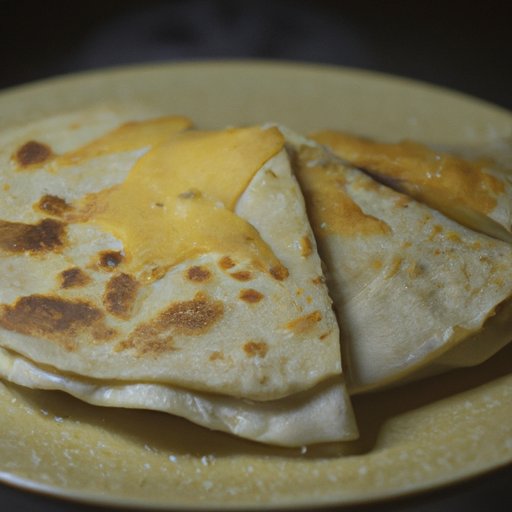Introduction
Cheese quesadillas are a popular Mexican dish that consists of a flour or corn tortilla filled with cheese and other ingredients such as vegetables, meats, and beans. They are usually served hot and can be eaten as a snack or meal. While cheese quesadillas are a tasty treat, it is important to consider their nutritional value before adding them to your diet.

Exploring the Health Benefits of Cheese Quesadillas
Cheese quesadillas can provide some health benefits, including protein, calcium, and vitamins and minerals. Protein helps build and repair muscle and can help keep you feeling full and satisfied. Cheese is also a great source of calcium, which is essential for healthy bones and teeth. Additionally, cheese contains a variety of vitamins and minerals, including vitamin A, B12, and zinc.
Is Eating a Cheese Quesadilla Good for You?
While cheese quesadillas have some nutritional benefits, they can also be high in calories, fat, and sodium. It is important to look at the nutritional content of the ingredients used to make the quesadilla, as well as the portion size. Most restaurants serve large portions of cheese quesadillas, so it is best to split one with a friend or save half for later. Additionally, if you are watching your calorie intake, it is best to choose a lower-fat cheese option.
A Nutritionist’s Guide to Eating Cheese Quesadillas
If you want to enjoy cheese quesadillas without sacrificing your health, there are some easy steps you can take. Choose low-fat cheese or non-dairy alternatives such as soy cheese. Use whole wheat tortillas instead of white flour, and add vegetables and other healthy ingredients like beans and lean meats. This will not only increase the nutritional value of your quesadilla, but it will also give it more flavor.
Healthy Alternatives to Cheese Quesadillas
If you are looking for a healthier alternative to cheese quesadillas, there are several options. Bean burritos are a great choice, as they are packed with protein and fiber. Hummus wraps are also a delicious and nutritious option, as hummus is rich in vitamins and minerals. Veggie burgers are another healthy alternative, as they contain no animal products and are high in fiber.

How to Make a Healthy Cheese Quesadilla
Making a healthy cheese quesadilla is simple. Start by gathering the ingredients: whole wheat tortillas, low-fat cheese, and your favorite vegetables and other healthy ingredients. Heat a skillet over medium heat and spray with cooking oil. Place a tortilla in the skillet and sprinkle with cheese. Add the desired ingredients and top with another tortilla. Cook for 1-2 minutes on each side, flipping carefully. Serve warm.
The Pros and Cons of Eating Cheese Quesadillas
Eating cheese quesadillas has both pros and cons. On the plus side, they are a quick and easy meal that can be made in large batches. They are also very versatile, as you can customize them with different ingredients. However, cheese quesadillas can be high in fat and calories, and the sodium content can be high as well. It is important to consider these factors when deciding whether or not to include cheese quesadillas in your diet.

A Look at the Nutritional Value of Cheese Quesadillas
Cheese quesadillas vary in nutritional value depending on the ingredients used. Generally, a typical cheese quesadilla contains around 200-300 calories, 10-15 grams of fat, and 500-600 milligrams of sodium. It also contains 8-10 grams of protein and 2-3 grams of fiber. The nutritional content of cheese quesadillas can be further modified by choosing lower-fat cheese and other healthy ingredients.
Conclusion
Cheese quesadillas can be a convenient and tasty snack or meal, but it is important to consider their nutritional content before eating them. Cheese quesadillas are high in fat, calories, and sodium, but they can also provide some health benefits such as protein, calcium, and vitamins and minerals. To make a healthier cheese quesadilla, choose low-fat cheese, use whole wheat tortillas, and add vegetables and other healthy ingredients. There are also many healthy alternatives to cheese quesadillas, such as bean burritos, hummus wraps, and veggie burgers.
(Note: Is this article not meeting your expectations? Do you have knowledge or insights to share? Unlock new opportunities and expand your reach by joining our authors team. Click Registration to join us and share your expertise with our readers.)
